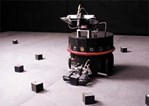NOMAD— A thinking machine created by The Neurosciences Institute


According to staff neuroscientist Jeffrey Kirchmar, NOMAD is more than a robot, it's an autonomous being that he and others are using to study how the brain controls behavior. "NOMAD starts naïve and learns from experience. It has a preference for light and a specific taste, but no other experience or programming," Krichmar explains. NOMAD currently behaves like an infant.
Simulated brain cells control NOMAD's behavior, allowing researchers a unique window into brain mechanisms produce the range of behaviors associated with higher brain functions. The simulated brain of Darwin includes visual and motor areas that are connected with NOMAD by telemetry. Darwin has been trained to track a light moving in a random path, after which training it will approach colored blocks and collect them to a home position. Certain blocks, striped for example, will give Darwin an electric charge when it picks it up, which, in machine parlance, is good taste. Those that don't give an electrical impulse are perceived as bad. Darwin can learn by associating the stimulus with the block color what blocks to pick up, much like Pavlov's dog.
Darwin exemplifies synthetic neural modeling, a technique in which computer simulations are employed to analyze the interactions among the nervous system, the phenotype, and the environment of a designed organism as behavior develops. Darwin retains the advantages of synthetic neural modeling while avoiding the difficulties and pitfalls of attempting to simulate a rich environment in addition to a brain.
"We are adding a third sense to NOMAD's repertoire; an auditory system," said Krichmar. The simulated auditory system has areas to categorize and locate a sound, he added. A tone is associated with the taste of the block (high-pitched from a striped block, low-pitched from a spotted block). When the block detects NOMAD's presence, it starts to beep.
Future plans are to give NOMAD a long-term memory that will enable it to remember objects and events and put them into context.
"Our main objective is to use NOMAD to test theories of the brain," Krichmar explained. "By analyzing its brain we hope to better understand how the human brain works. With this brain we can also model neurological diseases."
The implications of this research may include the development of better diagnostic tools for patients with neurological diseases, and improved methods for learning.
"Perhaps most exciting," Snook added, "will be the development of new pattern-recognition devices, based on the brain, that will communicate with digital computers."
Founded in 1981, The Neurosciences Institute is an independent, non-profit scientific research organization that studies the biological bases of higher brain functions, such as consciousness and memory. It is supported entirely by private donations.
For more information: The Neurosciences Institute, 10640 John Jay Hopkins Dr., San Diego, CA 92121. Tel: 858-626-2000.
Edited by Laura DeFrancesco
Editor, Bioresearch Online
